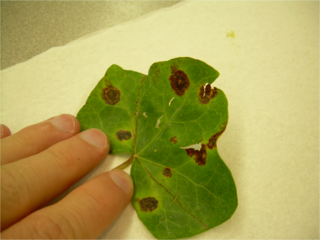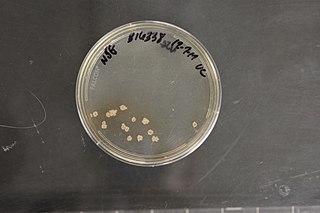
Rickettsia is a genus of nonmotile, gram-negative, nonspore-forming, highly pleomorphic bacteria that may occur in the forms of cocci, bacilli, or threads. The term "rickettsia" has nothing to do with rickets ; the bacterial genus Rickettsia instead was named after Howard Taylor Ricketts, in honor of his pioneering work on tick-borne spotted fever.

Nanoarchaeota is a proposed phylum in the domain Archaea that currently has only one representative, Nanoarchaeum equitans, which was discovered in a submarine hydrothermal vent and first described in 2002.

The Xanthomonadales are a bacterial order within the Gammaproteobacteria. They are one of the largest groups of bacterial phytopathogens, harbouring species such as Xanthomonas citri, Xanthomonas euvesicatoria, Xanthomonas oryzae and Xylella fastidiosa. These bacteria affect agriculturally important plants including tomatoes, bananas, citrus plants, rice, and coffee. Many species within the order are also human pathogens. Species within the genus Stenotrophomonas are multidrug resistant opportunistic pathogens that are responsible for nosocomial infections in immunodeficient patients.
The Coriobacteriales are an order of Actinomycetota.
Rubrobacter is a genus of Actinomycetota. It is radiotolerant and may rival Deinococcus radiodurans in this regard.
Sphaerobacter is a genus of bacteria. When originally described it was placed in its own subclass (Spahaerobacteridae) within the class Actinomycetota. Subsequently, phylogenetic studies have now placed it in its own order Sphaerobacterales within the phylum Thermomicrobiota. Up to now there is only one species of this genus known. The closest related cultivated organism to S. Thermophilus is the Thermomicrobium Roseum and has an 87% sequence similarity which indicates that S. Thermophilus is one of the most isolated bacterial species.[4]

The Nocardiaceae are a family of aerobic, non-fastidious, high G+C, Gram-positive actinomycetes that are commonly found in soil and water. Members of this family have been isolated from Antarctic soils. Nocardiaceae present coccobacilli, filamentous or, rarely, fragmented and palisading forms, and filamentous species grow in a branching morphological pattern similar to fungal hyphae.

Deinococcus is in the monotypic family Deinococcaceae, and one genus of three in the order Deinococcales of the bacterial phylum Deinococcota highly resistant to environmental hazards. These bacteria have thick cell walls that give them Gram-positive stains, but they include a second membrane and so are closer in structure to Gram-negative bacteria. Deinococcus survive when their DNA is exposed to high doses of gamma and UV radiation. Whereas other bacteria change their structure in the presence of radiation, such as by forming endospores, Deinococcus tolerate it without changing their cellular form and do not retreat into a hardened structure. They are also characterized by the presence of the carotenoid pigment deinoxanthin that give them their pink color. They are usually isolated according to these two criteria. In August 2020, scientists reported that bacteria from Earth, particularly Deinococcus bacteria, were found to survive for three years in outer space, based on studies conducted on the International Space Station. These findings support the notion of panspermia, the hypothesis that life exists throughout the Universe, distributed in various ways, including space dust, meteoroids, asteroids, comets, planetoids or contaminated spacecraft.
Acidothermus cellulolyticus is a species of gram-variable bacteria. It is the only member of the genus Acidothermus and the family Acidothermaceae.

The Glycomycetaceae are a family of bacteria.
Intrasporangiaceae is an actinomycete family. The family is named after the type genus Intrasporangium. The type species of Intrasporangium was originally thought to form endospores; however, the mycelium of this strain may bear intercalary vesicles that were originally identified as spores. No members of Intrasporangiaceae are known to form spores.
Caldicellulosiruptor saccharolyticus is a species of thermophilic, anaerobic cellulolytic bacterium. It was isolated from a piece of wood floating in the flow from a freshwater thermal spring in New Zealand in 1987, and tentatively named Caldocellum saccharolyticum. In 1994, the isolate was more thoroughly characterized physiologically, and classified to a new genus, Caldicellusiruptor, based on 16S RNA sequence. It is the type species, and more thoroughly studied member of its genus.
Jonesiaceae is a family of Actinomycetota.
Promicromonosporaceae is an Actinomycete family.

The Acidimicrobiia are a class of Actinomycetota, in which three families, eight genera, and nine species have been described, Acidimicrobium ferrooxidans is the type species of the order.
Dietzia maris is a Gram-positive and aerobic bacterium from the genus Dietzia.
Tsukamurella is a Gram-positive, non-spore-forming, rod-shaped and obligate aerobic bacterial genus from the family of Tsukamurellaceae. Most of the strains of Tsukamurella degrade starch. Some Tsukamurella species can cause infections in humans.
The Coriobacteriia are a class of Gram-positive bacteria within the Actinomycetota phylum. Species within this group are nonsporulating, strict or facultative anaerobes that are capable of thriving in a diverse set of ecological niches. Gordonibacter species are the only members capable of motility by means of flagella within the class. Several species within the Coriobacteriia class have been implicated with human diseases that range in severity. Atopobium, Olsenella, and Cryptobacterium species have responsible for human oral infections including periodontitis, halitosis, and other endodontic infections. Eggerthella species have been associated with severe blood bacteraemia and ulcerative colitis.
The Sporichthyaceae are the only family of the order Sporichthyales, which is a part of the phylum Actinomycetota.
The Nocardiopsaceae are a family of bacteria.






